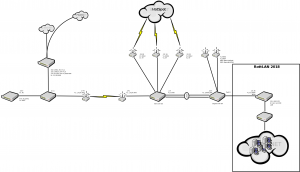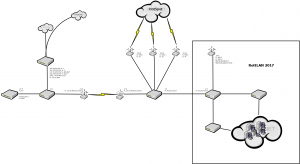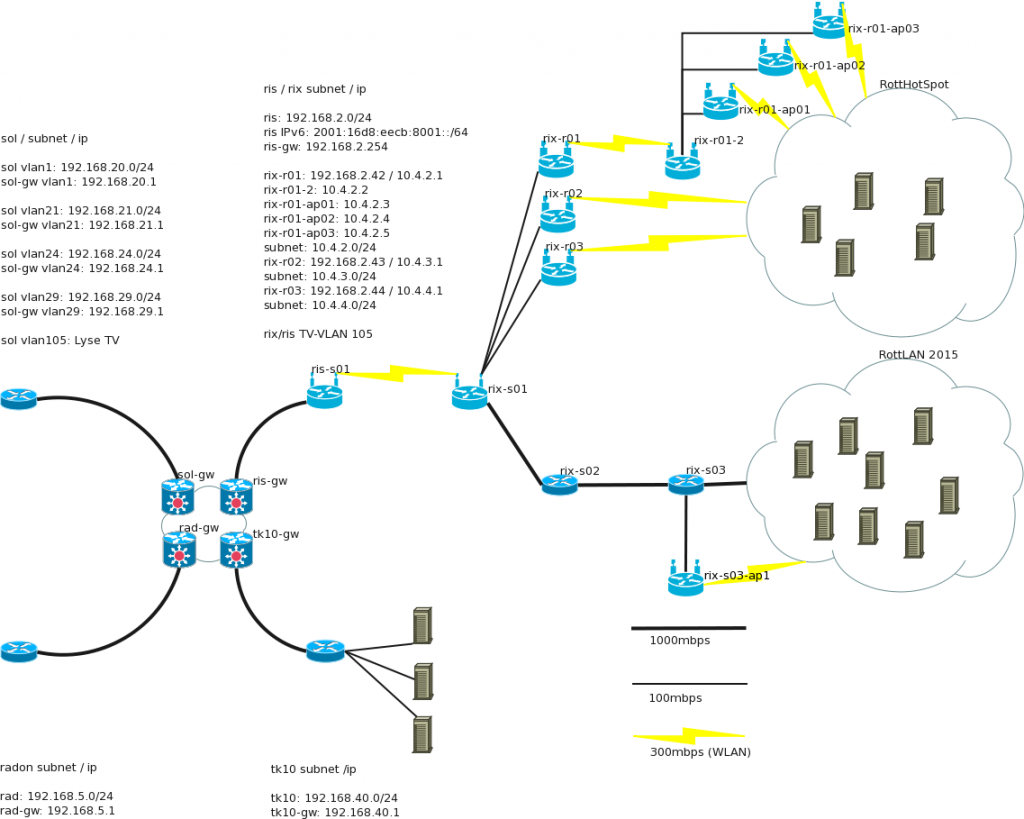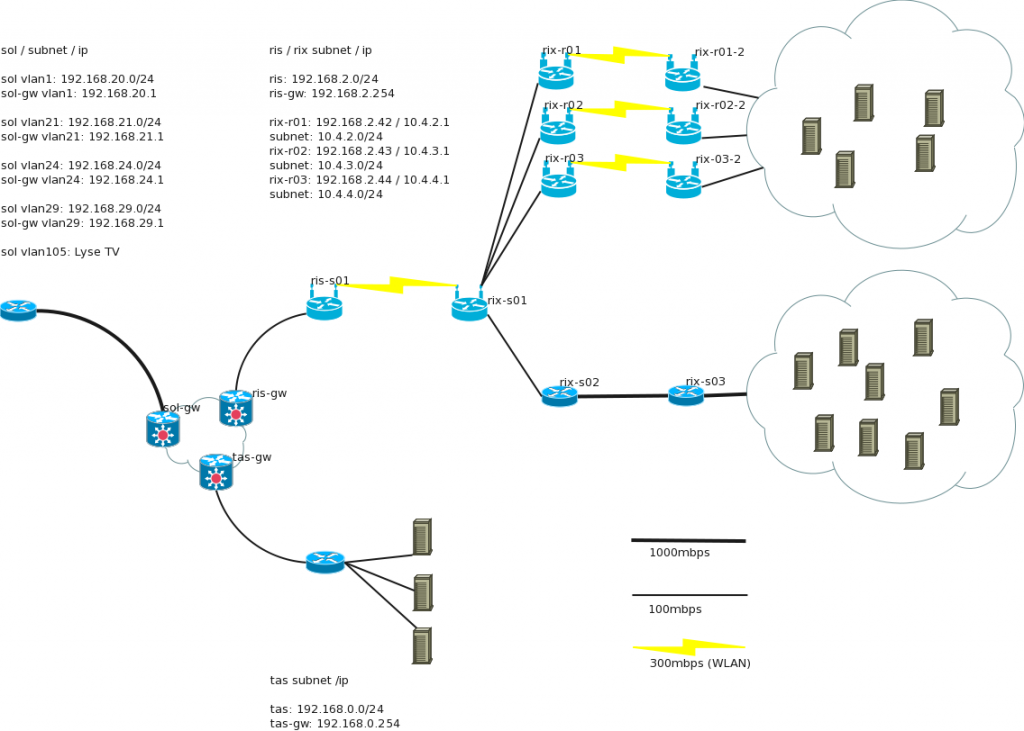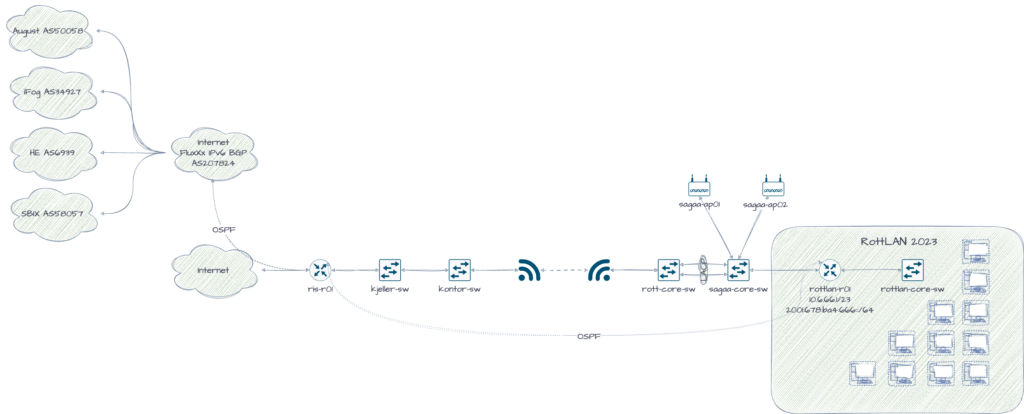
Category Archives: Nettverk
Design RottLAN 2018
Design RottLAN 2017
ODROID-C1 NTP Server
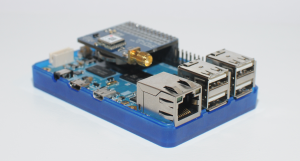 Based on the gps receiver from hab supplies, the work of jgilje and debian jessie I have been able to compile a minimal image which can work as a Stratum-1 ntp server.
Based on the gps receiver from hab supplies, the work of jgilje and debian jessie I have been able to compile a minimal image which can work as a Stratum-1 ntp server.
The image itself is ~90MB compressed, and contains a minimal installation of debian jessie, kernel from hardkernel with the pps-gpio patch from jgilje. ntp package was recompiled and is held from future updates. ntpd is preconfigured to use NMEA(127.127.20.0) driver with PPS sync. And udev rules to create the apropriate devices for ntpd to use. I also removed all of the dvb drivers in the kernel provided by hardkernel.
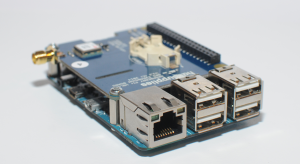 If you want to relocate the PPS signal to a different gpio pin, this can be done by altering the meson8b_odroidc.dts file and compiling it to an apropriate .dtb file.
If you want to relocate the PPS signal to a different gpio pin, this can be done by altering the meson8b_odroidc.dts file and compiling it to an apropriate .dtb file.
Image can be written to memory card using win32diskimager or dd, it will use dhcp for network configuration. Only user enabled is root with the password root. Framebuffer should also work, so you can connect it to a screen and configure it locally.
Things to do at first boot. Use fdisk to delete partition 2, and recreate the partition with the same size as the sd-card. Then resize the root partition.
Please note that on cold boot, it will take some time to lock onto the PPS.
Sources:
https://github.com/jgilje/pps-gpio-amlogic
http://ava.upuaut.net/store/index.php?route=product/product&path=59_60&product_id=117
Download:
odroidc1.img
Some ntpd output.
root@odroid-c1:~# ntpq -p
remote refid st t when poll reach delay offset jitter
==============================================================================
+ntp.fnutt.net 192.36.134.17 2 u 5 64 377 11.512 0.230 0.812
+2.81-166-42.cus 85.89.3.25 2 u 36 64 377 4.607 -0.430 0.612
+langbein.monslo 129.242.4.241 2 u 40 64 377 15.449 -1.063 0.953
-ntp-ext.cosng.n 146.213.3.181 2 u 24 64 377 14.528 1.604 1.253
oGPS_NMEA(0) .GPS. 0 l 12 16 377 0.000 -0.001 0.001
root@odroid-c1:~# ntpq -c rl
associd=0 status=0415 leap_none, sync_uhf_radio, 1 event, clock_sync,
version="ntpd 4.2.6p5@1.2349-o Mon May 25 18:52:44 UTC 2015 (1)",
processor="armv7l", system="Linux/3.10.75", leap=00, stratum=1,
precision=-20, rootdelay=0.000, rootdisp=0.354, refid=GPS,
reftime=d90ed892.9bbc5b1d Tue, May 26 2015 11:33:38.608,
clock=d90ed89b.4cfcafe8 Tue, May 26 2015 11:33:47.300, peer=59860, tc=4,
mintc=3, offset=-0.001, frequency=9.542, sys_jitter=0.001,
clk_jitter=0.001, clk_wander=0.000
Design RottLAN 2015
Ikke veldig mye har forandret seg siden 2012, men noen nye ting er det.
- Alle får dualstack (IPv4 / IPv6 ) addresser. IPv6 addressene er _helt_ åpne fra utsiden, mens IPv4 addressene er NATet.
- TV VLAN fra Risnes er tatt ut over trådløs link til RIX. Kan hvis ønskelig dras ned til “rix-s03”
CentOS 5 iSCSI target
På arbeidsstasjonen min har jeg en liten 120GB SSD disk, som blir litt for liten når den er delt mellom fedora og windows. Dette igjen betyr at jeg ikke har plass til å bruke windowsen til det den var tiltenkt(spill). Så løsningen ble for min del å lage en “sparse” fil som jeg igjen delte ut via iSCSI fra CentOS serveren min, og monterte denne igjen i windows. Dermed har jeg nå 400GB tilgjengelig uten at jeg bruker mer enn hva filene som ligger i “sparse” filen faktisk opptar.
Så over til smådetaljene.
root@server:/root $ yum install scsi-target-utils
root@server:/root $ cd /etc/tgt/
root@server:tgt $ vi targets.conf
<target iqn.2014-05.fluxxx.lan:workstation.target1>
backing-store /export/iscsi/workstation.img
</target>
root@server:iscsi $ dd if=/dev/zero of=workstation.img bs=1 count=0 seek=400G
root@server:iscsi $ /etc/init.d/tgtd start
root@server:iscsi $ chkconfig tgtd on
Da er i teorien iSCSI delt ut, så kan vi få det verifisert med kommandoen.
root@server:tgt $ tgtadm --lld iscsi --op show --mode target
Target 1: iqn.2014-05.fluxxx.lan:workstation.target1
System information:
Driver: iscsi
State: ready
I_T nexus information:
LUN information:
LUN: 0
Type: controller
SCSI ID: IET 00010000
SCSI SN: beaf10
Size: 0 MB, Block size: 1
Online: Yes
Removable media: No
Readonly: No
Backing store type: null
Backing store path: None
Backing store flags:
LUN: 1
Type: disk
SCSI ID: IET 00010001
SCSI SN: beaf11
Size: 429497 MB, Block size: 512
Online: Yes
Removable media: No
Readonly: No
Backing store type: rdwr
Backing store path: /export/iscsi/workstation.img
Backing store flags:
Account information:
ACL information:
ALL
Hvor mye plass er faktisk i bruk av selve “sparse” filen.
root@server:iscsi $ du -sh workstation.img
30G workstation.img
root@server:iscsi $ du -sh --apparent-size workstation.img
400G workstation.img
Design RottLAN 2012
SuperPXE
I forbindelse med at jeg tenkte å lære meg python, har jeg begynnt på ett lite prosjekt jeg kaller SuperPXE. Målet med prosjektet er ett webinterface hvor man kan velge å reinnstallere en maskin i nettverket med ett valgfritt OS.
Foreløpig er webserveren satt opp til å kjøre python programmet som leverer en “default” config, videre er planen at jeg skal få kompilert opp gPXE 0.9.6+ som automatisk peker mot serveren som inneholder python modulen. Systemet er i utgangspunktet to delt, hvor SuperPXE tar seg av parsingen av config filer, og webinterfacet står for selve opprettelsen av config filene. Hvis ingen config fil finnes, vil den vise standard menyen som vi alle kjenner.
